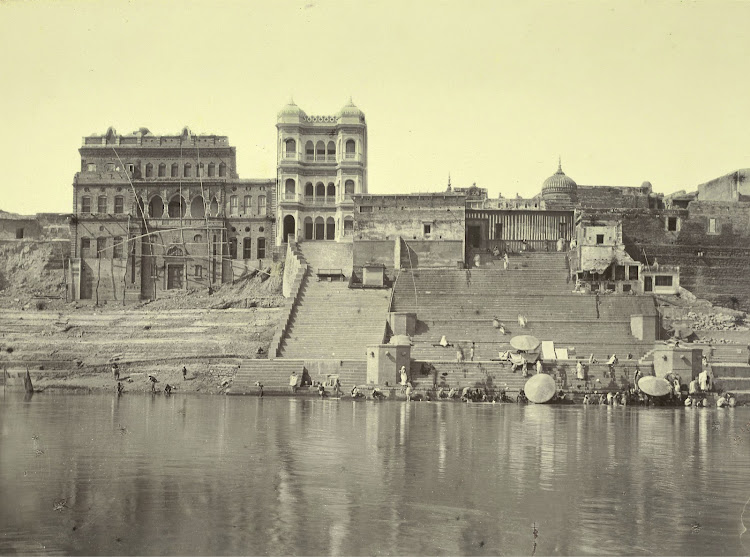Asi Ghat is situated at the confluence of the Asi and Ganges Rivers at
Varanasi in Uttar Pradesh. This is the southernmost ghat in the city
where pilgrims bathe prior to worshipping at two huge lingams (a phallus
worshipped as a symbol of the Lord Shiva). One of the lingams is under a
peepal tree and another known as the asisangameshvara (the ‘Lord of the
Confluence of the Asi’) is in a small marble temple just off the ghat.
Baji Rao's Ghat
Batsaraj Ghat has two Jain temples. Varanasi, founded in the sixth century BC is one of the seven sacred cities of the Hindus but is also holy for the Jains. According to Jain traditions it is the birthplace of four tirthankaras and is counted among Jain sacred tirthas.
Burning Ghat
Gai Ghat - In the 12th century the ghat marked the southern entrance to Varanasi and still retains the Patana Darvaja, a symbolic relic of that period. The name of the ghat is derived from the huge stone image on it of a Gai (Cow), which is considered to be holy and revered in Hinduism.
Ghosla Ghat
Kedar Ghat - The ghat is mythologically related to Kedarnath in the Himalayas which is Shivas mountain abode and has one of the 12 lingas of light. Above the steps of the ghat is the Temple which houses the Kedareshvaram Lingam. The walls of the temple with red and white stripes indicate southern Indian management. Its ghat become a busy during the sacred month of Sravana (July/August), the month of the rains.
Manikarnika Ghat
Mosque at Panchaganga Ghat. The mosque at this ghat, was built by Aurangzeb (r.1658-1707), the ruler of the Mughal Empire. The mosque is on the site of an earlier Vishnu temple known as Bindu Madhav, this is probably why the mosque is known locally as Madho Rai Ki Masjid. Parts from the temple were used in the construction of the mosque. The minarets (seen in this view), were restored by James Prinsep in the 19th century and further shortened before they were finally pulled down by the government due to their instability.
Nepalese temple at Lalita Ghat. The temple was built at the behest of the King of Nepal in the typical Kathmandu style using wood and woodcarvers brought from Nepal. The temple houses an image of Pashupateshwar which is a manifestation of Lord Shiva at Pashupatinath in the Kathmandu Valley.
Rana Mahal Ghat with a walled palace beyond, built by the Maharana of Udaipur
Shivala Ghat dominated by the Palace of Maharaja Chet Singh
Munshi Ghat was built by Munshi Shri Dhar, Dewan of the Raja of Nagpur.
Photographer: Madho Prasad
Source: British Library
Baji Rao's Ghat
Batsaraj Ghat has two Jain temples. Varanasi, founded in the sixth century BC is one of the seven sacred cities of the Hindus but is also holy for the Jains. According to Jain traditions it is the birthplace of four tirthankaras and is counted among Jain sacred tirthas.
Burning Ghat
Gai Ghat - In the 12th century the ghat marked the southern entrance to Varanasi and still retains the Patana Darvaja, a symbolic relic of that period. The name of the ghat is derived from the huge stone image on it of a Gai (Cow), which is considered to be holy and revered in Hinduism.
Ghosla Ghat
Kedar Ghat - The ghat is mythologically related to Kedarnath in the Himalayas which is Shivas mountain abode and has one of the 12 lingas of light. Above the steps of the ghat is the Temple which houses the Kedareshvaram Lingam. The walls of the temple with red and white stripes indicate southern Indian management. Its ghat become a busy during the sacred month of Sravana (July/August), the month of the rains.
Manikarnika Ghat
Mosque at Panchaganga Ghat. The mosque at this ghat, was built by Aurangzeb (r.1658-1707), the ruler of the Mughal Empire. The mosque is on the site of an earlier Vishnu temple known as Bindu Madhav, this is probably why the mosque is known locally as Madho Rai Ki Masjid. Parts from the temple were used in the construction of the mosque. The minarets (seen in this view), were restored by James Prinsep in the 19th century and further shortened before they were finally pulled down by the government due to their instability.
Nepalese temple at Lalita Ghat. The temple was built at the behest of the King of Nepal in the typical Kathmandu style using wood and woodcarvers brought from Nepal. The temple houses an image of Pashupateshwar which is a manifestation of Lord Shiva at Pashupatinath in the Kathmandu Valley.
Rana Mahal Ghat with a walled palace beyond, built by the Maharana of Udaipur
Shivala Ghat dominated by the Palace of Maharaja Chet Singh
Munshi Ghat was built by Munshi Shri Dhar, Dewan of the Raja of Nagpur.
Photographer: Madho Prasad
Source: British Library


















